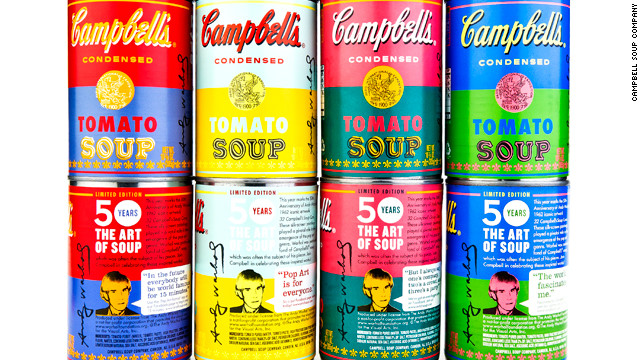 |
| Art and Soup |
It’s unclear to me what, exactly, is being licensed. . . . "The starting point, said [Michael Hermann, Director of Licensing for the Foundation], was to review all of Warhol’s Colored Soup Can paintings to find four images that worked well as a group and translated well as packaging. Then Campbell’s created labels derived from the original works.” That makes a little more sense. But the cans themselves (pictured above, from the LA Times) seem “Warholian” to me, rather than “Warhol.”
Deep cuts to funding heritage in Greece in USA Today
The Ministry of Culture's budget has been cut by 50% over the past two years, and deputy minister of culture Kostas Tzavaras says another 50% cut looms. But many here say that even if the cuts are a long time coming, they do not have to result in a reduction in care for Greece's architectural treasures. The Ministry of Culture has been renowned more for its spending sprees and ineptitude than its protection of monuments, analysts say. Former Culture minister Pavlos Geroulanos said he would resign after robbers stole dozens of priceless artifacts in February from a museum. Some of the bronze and pottery pieces dated from the ninth century B.C. and were protected by a single guard at the Archaeological Museum of the history of the Ancient Olympic Games. Still, the Culture Ministry says it has no choice but to pare back on things like paid security guards. "I didn't come like Santa Claus," Tzavaras said. "I don't have money to give away, like other ministers did."ART LAW SCHOOL « Clancco Yes, something called the art law school exists. Terrific idea:
The focus of the ART LAW SCHOOL is to introduce the artist to the “must-know” legal and business issues that arise when making art.
The Art Law Blog wonders about the big sale of Warhol's by the Warhol foundation: If it's not the tax exemptions, what is it?
No one would suggest that what the Warhol Foundation is doing is "unethical" or "repulsive" or "Stalinist." Nobody questions the right of artist-endowed foundations to sell work. Nobody claims those works are held in the public trust, to be accessible to present and future generations. But why? Why are works owned by, say, the Warhol Museum held in the public trust, while works owned by, say, the Warhol Foundation are not?The Daily Pennsylvanian : Turkish 'Troy gold' at Penn Museum stirs up controversy
The 24 pieces of “Troy gold” jewelry that the Penn Museum of Archaeology and Anthropology lent to the Turkish government in a landmark agreement announced Sept. 4 may have a more complicated history than meets the eye. Archaeology professor Brian Rose, a curator in the museum’s Mediterranean section, believes the artifacts arrived at Penn after they had been previously stolen. “I’m virtually certain they were looted,” said Rose, who has spent time studying the jewelry. “The question is from which region were they looted.” Penn had originally purchased the jewelry legally in 1966 from an antiquities dealer in Philadelphia without knowing all the details surrounding the artifacts’ history. “We bought it because it looked very like the gold that was excavated at Troy,” Penn Museum Director Julian Siggers said.Victims of forgery are "left in limbo" - The Art Newspaper
Art forgeries are once again in the news and getting more attention from law-enforcement agencies worldwide. But recent cases, including those of the German forger Wolfgang Beltracchi, the FBI investigation into art sold through the defunct New York-based Knoedler gallery, and the forgery of Indian Progressive pieces by the UK faker William Mumford, are leaving victims unsure of the legal position of works not examined in a court of law. The problem is that few of the fakes identified in forgery cases are ever recovered, and if they are, may not be considered by a judge as part of a trial. In the case of Mumford, just 40 of the 900 forgeries thought to have been made were brought before the court. Only 12 of the 58 fakes that police believe were made by Beltracchi were examined in his trial in Cologne in 2011. So what about the rest? And what can you do if you think you have a forged painting? At the moment, it seems it is up to the victims to try to extract reparations.Growth in Online Art Market Brings More Fraud - NYTimes.com
Over the last few years the Internet has broadened the art market far beyond the exclusivity and opaque jargon of its moneyed enclaves and has helped turn the slogan “art for everyone” into reality. But it has also become a sort of bazaar, where shoppers of varying sophistication routinely encounter all degrees of flimflammery, from the schemes of experienced grifters to the innocent mistakes of the unwitting and naïve. A recent study by statisticians at George Washington University and the University of California, Irvine, estimated that as many as 91 percent of the drawings and small sculptures sold online through eBay as the work of the artist Henry Moore were fake.
Abu Dhabi Police foils illegal sale of Dh2.5 million antique coins - The National
Abu Dhabi Police have thwarted the illegal Dh2.5m sale of four antique gold coins and a fake.And while four of the five coins were genuine, the fifth - also made of gold - appeared to be from the time of the 7th-century Umayyad caliph Abdul Malik ibn Marouan, but was a fake, Maj Gen Mohammed Al Menhali, the head of police operations at Abu Dhabi Police, told the Arabic-language daily Al Ittihad. A real coin from that period would have been worth around US$3m (Dh11m), he noted.
No comments:
Post a Comment